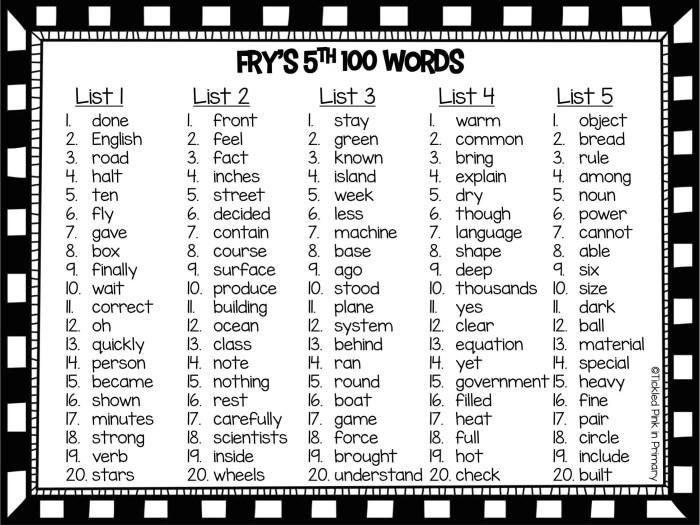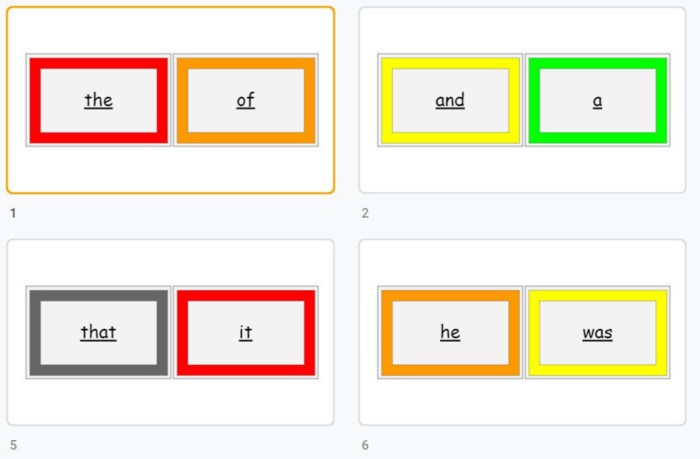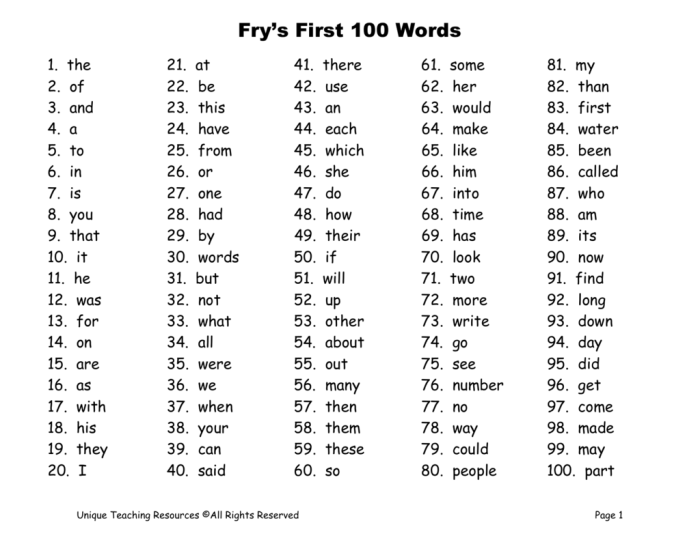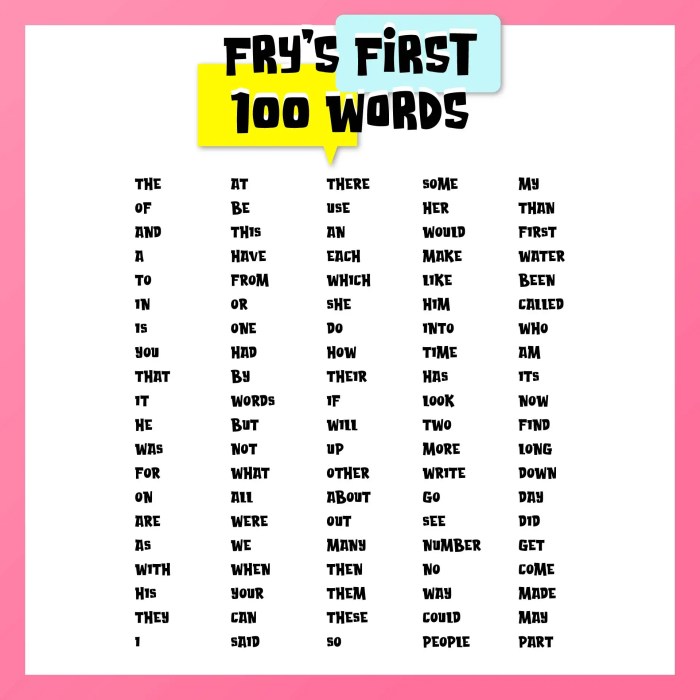List of fry’s first 100 words – Embark on an educational journey as we delve into the fascinating world of Fry’s first 100 words. This comprehensive guide unveils the significance, applications, and cultural impact of these foundational words in the realm of literacy.
Fry’s meticulous research has left an enduring legacy, shaping the teaching of reading and writing, and influencing literacy development worldwide. Join us as we explore the intriguing history, practical applications, and enduring impact of Fry’s first 100 words.
List of Fry’s First 100 Words

Fry’s First 100 Words is a list of the most common words used in the English language. It was compiled by Edward Fry in 1957 and is still used today to teach children how to read.
The words on the list are organized by frequency of usage, with the most common words appearing at the top. This makes it easier for children to learn the words that they will encounter most often in their reading.
Words in Alphabetical Order
- a
- about
- all
- am
- an
- and
- any
- are
- as
- at
- be
- been
- but
- by
- called
- can
- come
- could
- day
- did
- do
- does
- down
- each
- for
- from
- get
- go
- going
- good
- had
- has
- have
- he
- her
- here
- him
- his
- how
- I
- if
- in
- into
- is
- it
- its
- just
- know
- like
- long
- look
- made
- make
- man
- many
- me
- men
- more
- most
- must
- my
- new
- no
- not
- now
- of
- on
- one
- only
- or
- other
- our
- out
- over
- people
- said
- same
- saw
- say
- see
- she
- so
- some
- something
- sound
- take
- tell
- ten
- than
- that
- the
- their
- them
- then
- there
- these
- they
- this
- those
- though
- thought
- time
- to
- today
- two
- under
- up
- use
- very
- want
- was
- way
- we
- well
- went
- were
- what
- when
- where
- which
- who
- why
- will
- with
- word
- work
- would
- write
- you
- your
Historical Significance of Fry’s First 100 Words
Edward Fry’s identification of the first 100 words has significantly influenced the field of education. These words form the foundation of literacy development and serve as a cornerstone for early reading instruction.
Fry’s research, conducted in the 1950s, aimed to identify the most frequently used words in English. His analysis of written texts revealed that the first 100 words accounted for a substantial portion of the text. This discovery led to the realization that teaching these high-frequency words could significantly improve reading fluency and comprehension.
Educational Impact
Fry’s first 100 words have become an essential component of early literacy instruction. By focusing on these frequently used words, educators can help students develop a strong foundation in reading. These words provide a solid base for expanding vocabulary and building reading skills.
Cultural and Societal Context, List of fry’s first 100 words
Fry’s research was conducted during a period of significant educational reform in the United States. The 1950s saw a growing emphasis on improving literacy rates and expanding access to education. Fry’s work aligned with these goals, providing a practical and effective method for teaching reading.
The cultural and societal context of the time also influenced Fry’s research. The post-World War II era witnessed a surge in the availability of printed materials, leading to an increased demand for literacy skills. Fry’s work responded to this need, helping to equip students with the tools necessary to navigate the expanding world of written communication.
Applications of Fry’s First 100 Words in Education

Fry’s first 100 words form the foundation of early literacy development. Educators leverage these words to foster reading and writing skills in young learners.
Instructional Strategies
- Sight Word Recognition:Repeated exposure to Fry’s words helps children recognize them instantly, improving reading fluency.
- Phonics Instruction:These words provide a solid base for phonics instruction, allowing students to decode unfamiliar words.
- Writing Practice:Incorporating Fry’s words into writing activities promotes spelling proficiency and sentence construction.
Lesson Plan Example
Kindergarten Reading Lesson:
While learning about the fascinating list of Fry’s first 100 words, one may also be curious about the delectable offerings at Walk-Ons Bistreaux & Bar. From refreshing cocktails to tantalizing beers, the walk ons drink menu prices are sure to quench any thirst.
But returning to our exploration of language acquisition, Fry’s list of first words provides a glimpse into the development of human communication.
- Introduction:Introduce 5-10 Fry’s words using flashcards or a word wall.
- Practice:Have students read the words aloud, identify them in a text, and write them from memory.
- Application:Create a simple sentence using the words, encouraging students to read and write it.
Effectiveness
Research has consistently shown that incorporating Fry’s first 100 words into early literacy instruction significantly improves reading and writing outcomes. By providing a strong foundation of high-frequency words, educators empower students to become confident and proficient readers and writers.
Fry’s First 100 Words in Different Languages

Edward Fry’s first 100 words are a widely recognized list of high-frequency words in the English language. While the specific words included in the list may vary across languages, the concept of identifying a core set of commonly used words is applicable to different linguistic contexts.
To explore the cross-linguistic similarities and differences in high-frequency words, we can compare Fry’s first 100 words to their counterparts in other languages. The following table provides a sample comparison:
| Language | Word | Translation | Pronunciation | Cultural Significance |
|---|---|---|---|---|
| English | the | el | /ðə/ | Used to indicate a specific or general object or idea. |
| Spanish | el | the | /el/ | Similar to English, used as a definite article. |
| French | le | the | /lə/ | Similar to English and Spanish, used as a definite article. |
| Chinese | 的 | of | /də/ | Used as a possessive particle or to indicate a relationship between two nouns. |
| Japanese | は | is | /ha/ | Used to indicate the subject of a sentence or to mark a topic. |
As we can observe from the table, there are both similarities and differences across languages in terms of high-frequency words. Some words, such as “the,” appear in multiple languages with similar meanings and functions. Others, like “of” and “is,” may have different translations but serve similar grammatical roles.
Additionally, cultural factors can influence the inclusion of certain words in the high-frequency list, such as the use of “的” in Chinese to indicate possession.
Understanding the variations in high-frequency words across languages is crucial for language learners, educators, and researchers. It helps in developing effective teaching strategies, creating language learning materials, and gaining insights into the structure and usage of different languages.
Impact of Fry’s First 100 Words on Popular Culture

Fry’s First 100 Words have left an indelible mark on popular culture, permeating various forms of media and inspiring creative expression.
In literature, these words have served as building blocks for countless stories, poems, and essays. Authors have employed them to craft accessible and impactful narratives, ensuring that even young readers can engage with complex themes.
Literary Examples
- In J.D. Salinger’s The Catcher in the Rye, the protagonist Holden Caulfield frequently uses Fry’s words to express his youthful angst and alienation.
- Children’s book author Eric Carle has incorporated Fry’s words into his beloved Brown Bear, Brown Bear, What Do You See?, making it a classic that fosters early literacy.
Fry’s First 100 Words have also found a home in music, where they have been used as lyrics, titles, and even entire song concepts.
Musical Examples
- Bob Dylan’s “Blowin’ in the Wind” features the line “How many times can a man turn his head / Pretending that he just doesn’t see?”
- The Beatles’ “All You Need Is Love” includes the lyric “There’s nothing you can do that can’t be done.”
Beyond literature and music, Fry’s First 100 Words have influenced other forms of media, including film, television, and advertising. Their simplicity and universality have made them an effective tool for conveying messages and creating emotional connections.
Other Cultural Impacts
- The words have been used in educational campaigns to promote literacy and language development.
- They have been incorporated into merchandise, such as T-shirts, mugs, and posters, celebrating their cultural significance.
Fry’s First 100 Words continue to inspire and shape popular culture, demonstrating their enduring legacy and the transformative power of language.
FAQ Summary
What is the significance of Fry’s first 100 words?
Fry’s first 100 words represent the most frequently used words in the English language, making them essential for building a strong reading foundation.
How are Fry’s first 100 words used in education?
Educators use Fry’s first 100 words to teach phonics, sight word recognition, and vocabulary development.
What is the cultural impact of Fry’s first 100 words?
Fry’s first 100 words have been referenced in popular culture, including literature, music, and film, highlighting their enduring significance.